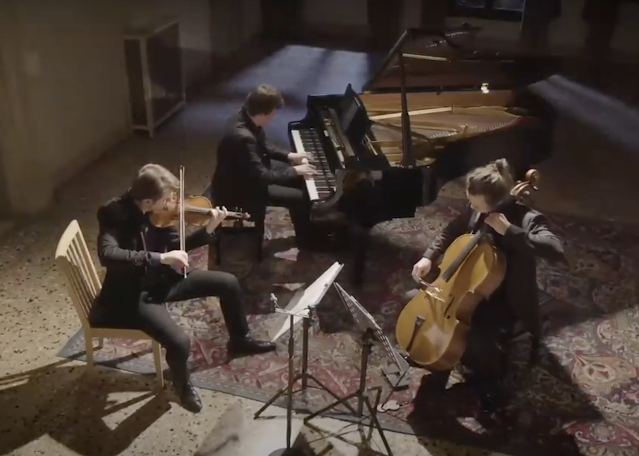Trio Messiaen (live stream), 11/02/2021
Chausson : Piano Trio
Saint-Saëns : Piano Trio No. 2
Trio Messiaen
David Petrlik, violin
Volodia Van Keulen, cello
Philippe Hattat, piano
Since its foundation in 2009, the Palazetto Bru Zane has accustomed its music-loving public to a persistent excellence of production in its research and promotion of French Romantic music. They push the boat out a little by taking the period of research right up to 1920, but who's complaining when the results are of such consistently high quality. Their CDs are works of art, beautifully presented with detailed and fascinating documentation included - my only complaint there is that their opera CDs don't physically fit on regular shelving! They now have a web radio station, and a YouTube channel which, particularly since the onset of the pandemic, regularly tranmits live recitals from their Venetian base.
The contents of tonight's recital were, by Bru Zane standards, positively popular. They can and do regularly venture into far more esoteric realms than these two piano trios which are passably represented in the CD catalogues. However, it's the kind of repertory I normally only get to hear during summer festivals; it's not at all popular in the UK, and the young Trio Messiaen delivered beautiful performances of both, different as they are.
The Chausson Trio is an early piece. Chausson came to formal music studies relatively late, he was 24 before he entered the Conservatoire, and the Trio was written when he was 26. The stamp of César Franck, who Chausson greatly admired, is already very clear, not least in the loosely cyclical form that brings back themes from the start to the finish. Chausson's best-known chamber work is undoubtedly the Concert for violin, piano and string quartet, written ten years later, and you can hear the seeds clearly in the Trio, in the intense chromaticism, and the dense, swirling clouds of harmony. Interestingly, the spotlight is, for the most part, very firmly on the two string instruments. It would be misleading to say that the piano fills simply an accompanying role; there is nothing remotely simple about the piano writing. However, particularly in the first movement, it's more like a fine jewellery setting, elaborate and lovely, but the focus is on the passionate, burning gems that are the violin and cello lines.
The Saint-Saëns second Trio dates from about two decades later, and is the work of a mature composer, Saint-Saëns being in his late fifties. The differences could hardly be greater, and are immediately apparent. Where the piano writing in the Chausson is thick, complex, rich and heavy, Saint-Saëns's is no less virtuosic, but far more transparent. The first movement begins with striking figuration, repeated chords in a rising and falling wave pattern, played with great delicacy by Philippe Hattet, while the main theme is introduced by violin and cello playing in unison, and Petrlik and Van Keulen displaying their beautiful compatibility of tone. Saint-Saëns was not a follower of Franck, and his music eschews the Wagner-inspired sensuality of Chausson's writing for something clearer and lighter, yet he claims his own form of originality with the five-movement structure of the trio, and touches like the quirky, limping, five-in-a-bar rhythm of the second movement, and the hints of a ländler in the fourth. The fugue in the last movement is a bit of a surprise, but as well as being one of the foremost pianists of his age, Saint-Saëns was also one of the foremost organists. As such, counterpoint was always close to his heart, and he revels in its exercise, and it was perfectly handled by the trio,
This was a delightful concert, from start to finish. From the heady, hothouse atmosphere of the Chausson to the lighter, yet no less passionate moods of the Saint-Saëns, the Trio Messiaen gave a clear, well-nigh flawless performance of clear focus and commitment, well worth catching up on while still available on-line.


